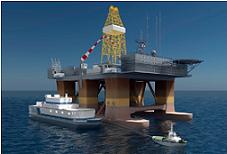Russia's Floating Nuclear Plants
 Article by James Kanter of The New York Times. The United Industrial Corporation, a Russian manufacturer, said this week that the world’s first floating nuclear power plant will go into operation on Russia’s eastern coast by the end of 2012.
Article by James Kanter of The New York Times. The United Industrial Corporation, a Russian manufacturer, said this week that the world’s first floating nuclear power plant will go into operation on Russia’s eastern coast by the end of 2012.The manufacturer, known also as O.P.K., told Green Inc. that the first model would be used to help power Viluchinsk, a city on the Kamchatka peninsula that serves as an atomic submarine base.
O.P.K. said similar models could power other cities in northern Russia in the future. But according to nuclear experts, mining companies are likely to use Russian-built floating reactors to power operations to extract oil and gas and valuable minerals from the Arctic and other remote regions.
O.P.K. is building the plant in the shape of a ship 144 meters (472 feet) in length and 30 meters (98 feet) wide to accommodate two 35-megawatt reactors. Construction of the plant, called KLT-40C, began in February this year.
Concern Energoatom, a nuclear power plant operator, signed a contract this month to buy the first model, worth 226.8 million euros, O.P.K. said.
The cost of the reactors per kilowatt hour would be equal to building a hydropower station and “exploitation of such a particular plant will be much in demand both in industrial and developing regions,” O.P.K. said.
The advantages of floating nuclear plants include maneuverability of the machines so that they can be serviced, as well as the ability to be towed near remote settlements or sites of energy-intensive industries - like water desalination - where need is greatest for electricity.
Other potential benefits include the offshore locale, away from population areas where residents might otherwise object to the presence of nuclear power.
But putting reactors at sea is likely to raise concerns about the safety in extreme weather conditions, vulnerability to terrorism, and disposal of the radioactive waste they produce.
You can return to the main Market News page, or press the Back button on your browser.

